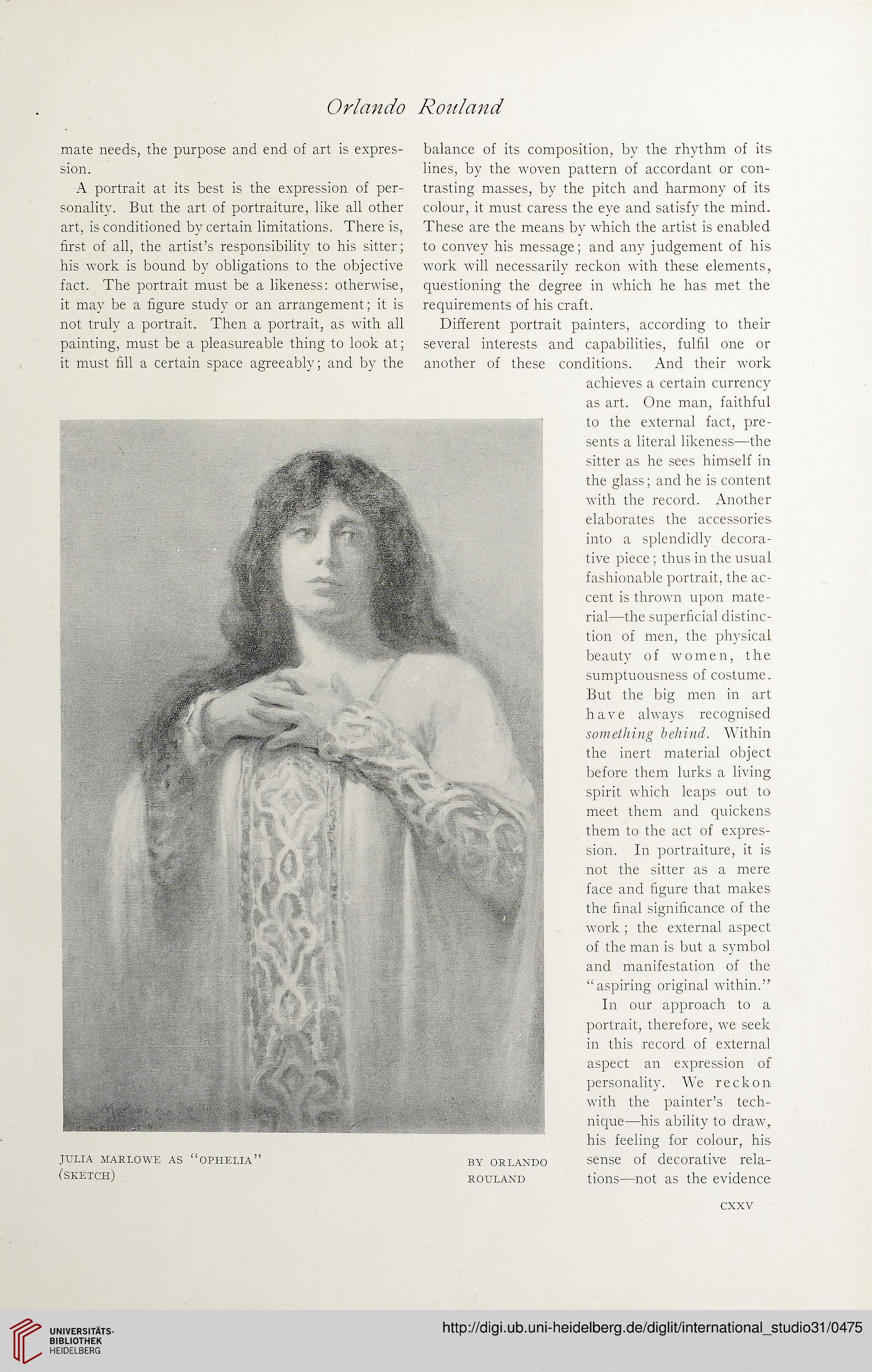Orlando Rouland
mate needs, the purpose and end of art is expres-
sion.
A portrait at its best is the expression of per-
sonality. But the art of portraiture, like all other
art, is conditioned by certain limitations. There is,
first of all, the artist’s responsibility to his sitter;
his work is bound by obligations to the objective
fact. The portrait must be a likeness: otherwise,
it may be a figure study or an arrangement; it is
not truly a portrait. Then a portrait, as with all
painting, must be a pleasureable thing to look at;
it must fill a certain space agreeably; and by the
JULIA MARLOWE AS “OPHELIA”
(sketch)
balance of its composition, by the rhythm of its
lines, by the woven pattern of accordant or con-
trasting masses, by the pitch and harmony of its
colour, it must caress the eye and satisfy the mind.
These are the means by which the artist is enabled
to convey his message; and any judgement of his
work will necessarily reckon with these elements,
questioning the degree in which he has met the
requirements of his craft.
Different portrait painters, according to their
several interests and capabilities, fulfil one or
another of these conditions. And their work
achieves a certain currency
as art. One man, faithful
to the external fact, pre-
sents a literal likeness—the
sitter as he sees himself in
the glass; and he is content
with the record. Another
elaborates the accessories
into a splendidly decora-
tive piece ; thus in the usual
fashionable portrait, the ac-
cent is thrown upon mate-
rial—the superficial distinc-
tion of men, the physical
beauty of women, the
sumptuousness of costume.
But the big men in art
have always recognised
something behind. Within
the inert material object
before them lurks a living
spirit which leaps out to
meet them and quickens
them to the act of expres-
sion. In portraiture, it is
not the sitter as a mere
face and figure that makes
the final significance of the
work ; the external aspect
of the man is but a symbol
and manifestation of the
“aspiring original within.’r
In our approach to a
portrait, therefore, we seek
in this record of external
aspect an expression of
personality. We reckon
with the painter’s tech-
nique—his ability to draw,
his feeling for colour, his
by orlando sense of decorative rela-
rouland tions—not as the evidence
cxxv
mate needs, the purpose and end of art is expres-
sion.
A portrait at its best is the expression of per-
sonality. But the art of portraiture, like all other
art, is conditioned by certain limitations. There is,
first of all, the artist’s responsibility to his sitter;
his work is bound by obligations to the objective
fact. The portrait must be a likeness: otherwise,
it may be a figure study or an arrangement; it is
not truly a portrait. Then a portrait, as with all
painting, must be a pleasureable thing to look at;
it must fill a certain space agreeably; and by the
JULIA MARLOWE AS “OPHELIA”
(sketch)
balance of its composition, by the rhythm of its
lines, by the woven pattern of accordant or con-
trasting masses, by the pitch and harmony of its
colour, it must caress the eye and satisfy the mind.
These are the means by which the artist is enabled
to convey his message; and any judgement of his
work will necessarily reckon with these elements,
questioning the degree in which he has met the
requirements of his craft.
Different portrait painters, according to their
several interests and capabilities, fulfil one or
another of these conditions. And their work
achieves a certain currency
as art. One man, faithful
to the external fact, pre-
sents a literal likeness—the
sitter as he sees himself in
the glass; and he is content
with the record. Another
elaborates the accessories
into a splendidly decora-
tive piece ; thus in the usual
fashionable portrait, the ac-
cent is thrown upon mate-
rial—the superficial distinc-
tion of men, the physical
beauty of women, the
sumptuousness of costume.
But the big men in art
have always recognised
something behind. Within
the inert material object
before them lurks a living
spirit which leaps out to
meet them and quickens
them to the act of expres-
sion. In portraiture, it is
not the sitter as a mere
face and figure that makes
the final significance of the
work ; the external aspect
of the man is but a symbol
and manifestation of the
“aspiring original within.’r
In our approach to a
portrait, therefore, we seek
in this record of external
aspect an expression of
personality. We reckon
with the painter’s tech-
nique—his ability to draw,
his feeling for colour, his
by orlando sense of decorative rela-
rouland tions—not as the evidence
cxxv




